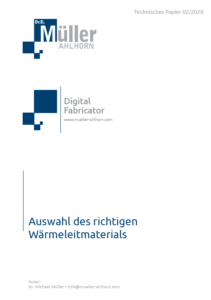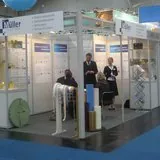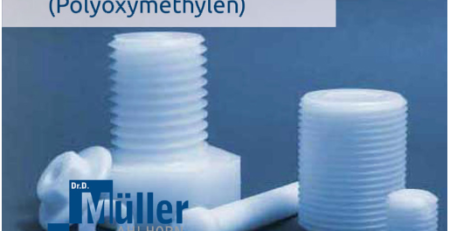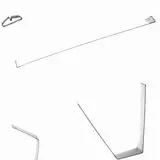Thermal interfaces - thermal interface materials
Ahlhorn | 17.12.2020/XNUMX/XNUMX
Function of thermally conductive materials
Thermally conductive materials, called Thermal Interface Material (TIM), are used in many areas of electronics where fast and efficient heat conduction is important. TIMS fill out bumps and thus enable better heat transfer from the component to the heat sink. Typical areas of application are heat-sensitive components where an active or passive cooler is used. It serves as an assembly aid for electronics, measurement and control technology and for improved heat dissipation from electronic components such as power transistors.
Types of thermal interface materials
phase change materials
What is special about phase change materials (PCMs) is that they change from a solid to a semi-solid phase with the heat of the working processor and a light clamping pressure. The semi-solid phase has the property of adapting to both surfaces very easily. The ability to completely fill the interface air gaps and surface voids under light clamping pressure allows this material to perform as well as thermal grease.
Thermal Compound
Thermally conductive pastes usually consist of silicone that is enriched with thermally conductive fillers. Curing is usually not necessary and they are free to flow and conform perfectly to the interfaces. The thermal interfaces can easily be reworked. However, it must be ensured that sufficient paste or grease has been applied before installing the heat sink.
Gap filler
One of the largest market segments for TIMs is gap fillers. These can be supplied in different strengths. Efficient, soft and good thermal conductors, these materials can cover gaps up to 15mm. The practical gap fillers can cover several components of different heights and then emit the heat to a common heat spreader.
thermal foil s
Thermally conductive foils not only transfer heat, but also provide electrical insulation. In terms of tear resistance and puncture resistance, the thermal films offer excellent durability. Silicone-containing and silicone-free (e.g. polyurethane filled with ceramics) heat-conducting foils and graphite materials fall into this category. The range of thermal conductivities and price ranges is wide, so everyone can find a good solution.
Thermal pads
Thermal pads are typically made from unreinforced silicone with conductive fillers. Thermal pad reinforcements are typically woven glass, metal foils, or polymeric films. The practical thermal pads are usually pre-cut in different sizes to accommodate components of different sizes. While phase change materials and thermal paste are clearly superior in terms of conductivity, the thermal pads have the advantage of being a cost-effective and convenient option for applications with lower cooling needs.
graphite foils
This inexpensive option has been used for a long time. The films are electrically conductive and can be used at very high temperatures of up to 500°C. Some vendors align the fibers horizontally. This leads to very different thermal conductivity measurements. There is material that shows 7,0 W/mK on the x-axis and 150,0 W/mK on the yz-axis - a clear difference.
Double-sided thermally conductive adhesive tapes
Thermal tape can be made from a finely woven, nickel-plated copper mesh that closely conforms to uneven mounting surfaces. PSA thermally conductive double-sided tapes are very commonly used to attach small heat sinks to components. Important factors here are peel strength, lap and punching strength, holding power and thermal resistance. In terms of heat conduction performance, the double-sided tapes are mid-range. You save on additional assembly parts, but the belts have problems with the irregular surfaces of the components and can therefore only be used to a limited extent. Plastic ICs are typically concave in the center and the heatsink surfaces also vary, which can lead to air gaps in the interface.
thermal adhesives
Thermally conductive adhesives - also called thermally conductive adhesives - can be either one-component or two-component systems. These are equipped with conductive fillers. The application is usually done by dosing or stencil printing. Curing of the adhesive is necessary to allow reliable crosslinking of the polymer that provides the adhesive property. The biggest advantage of this TIM is certainly the fact that the thermal adhesives provide structural support and therefore no mechanical clamping is required.
thermal yellow
Gels are a fat-like material that is slightly cross-linked. The behavior is correspondingly similar, which reduces the bleeding of the material.
TIMs made of metal
Metal thermally conductive materials can be made in all sorts of shapes and are no longer limited to soldering applications. In numerous applications, the metal TIMs can be reworked very well and are also easy to recycle.
Areas of application for thermal paste
The main area of application for thermal paste is in the field of electronics. In addition, thermally conductive pastes are used in the following industries, among others:
- IT hardware
- Plastics industry
- shoe machine industry
- foundries
- Apparatus construction and laboratory industry
- wood machinery industry
- packaging machine industry
- medical technology
- General Engineering
Preserved through the expansion of electromobility Thermal Compound n also in the field of power electronics, increasingly in the automotive sector.
Our brochure on thermal interface materials
When choosing the right thermal material, many people are unsure what exactly to look out for. In our brochure "Selection of the right thermal interface material" we would like to provide you with everything you need to know about heating materials.











